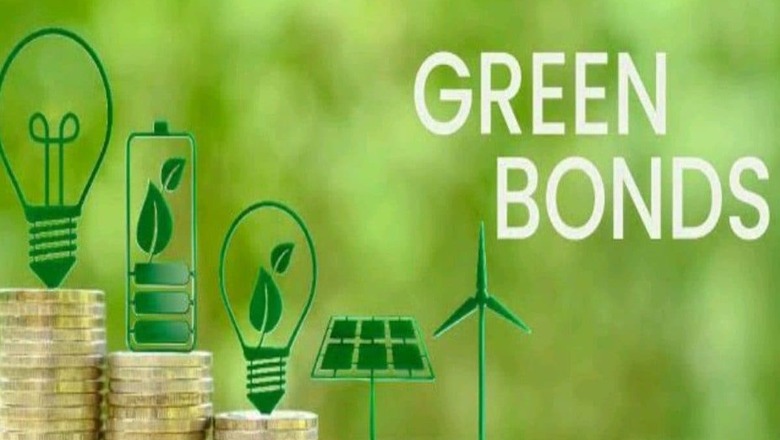
views
India Infrastructure Finance Company Ltd (IIFCL) is planning to raise Rs 2,000 crore through its maiden green bonds in the next six months to fund sustainable projects. It could be a mix of both domestic and foreign issuances, depending on the cost of funds. Last week, the State Bank of India (SBI) raised $250 million (about Rs 2,000 crore) through the issuance of green bonds maturing in 2028 via private placement. Similarly, since 2015, many Indian corporations and the Indian government have been promoting lending and financing via green bonds.
The furore over green bonds also led the Government of India to come out with a Green Bond Framework in 2022 and then issue the first tranche of its first sovereign green bond worth Rs 80 billion (equivalent to $980 million). On February 9, 2023, the government announced the issuance of another Rs 80 billion ($968 million) in sovereign green bonds.
India’s financial and fiscal landscape is undergoing rapid and transformative changes, driven by the government’s proactive measures to curb the country’s fiscal deficit. A significant milestone in this evolution is the introduction of green bonds, representing an innovative financing mechanism for environmentally beneficial projects.
Green bonds, as debt instruments, are issued to fund initiatives with a positive environmental impact, aiming to stimulate investments in areas such as renewable energy, energy efficiency, and sustainable agriculture. The government’s successful promotion of green bonds has effectively spurred investments in projects contributing to environmental sustainability. Consequently, these efforts have played a pivotal role in shaping a more sustainable financial and fiscal landscape in India.
What are Green Bonds?
Green bonds serve as debt instruments designed to secure capital for the funding of environmental or climate-related projects. While sharing similarities with conventional bonds, such as having fixed or variable interest rates, they distinguish themselves by being explicitly earmarked for the financing or refinancing of projects that positively impact the environment or climate.
Or in simple words, green bonds are a type of debt used to fund environment-friendly and sustainable projects. Unlike regular bonds, they are exclusively for initiatives like renewable energy, energy-efficient transportation, clean energy, sustainable water management, and reducing greenhouse gas emissions. Entities such as governments, corporations, or International Development Banks issue green bonds.
Green Bonds: Driving Sustainability in India’s Finance
Green bonds in India play a key role in financing or refinancing green or climate-related projects. They also serve as a means to raise funds for initiatives like renewable energy projects, clean transportation projects, eco-friendly farming projects, and other environmental infrastructure projects.
At the July G20 Summit last year, under India’s presidency, a significant accomplishment was the Leaders’ Declaration pledging to triple global renewable energy capacity by 2030. Not only that, but India has also pledged to lower current emissions by 2030 and become a net zero nation by 2070.
Expanding the renewable capacity to an estimated 11,000 GW and achieving its renewable and clean energy goals requires trillions of dollars in annual investments. With that in mind, India’s issuance of its inaugural sovereign green bonds marks the initiation of a potentially significant pillar in the country’s strategy to finance its decarbonisation objectives. Several estimates indicate that an annual investment of $160-200 billion is needed for India to attain its clean energy targets.
Sovereign green bonds underscore India’s dedication to expanding renewable energy production and reducing carbon intensity. They support expenditures for renewable energy and electrification of transport systems, crucial for addressing sectors responsible for 41 per cent of India’s GHG emissions in 2019, expected to rise to two-thirds by 2050.
The allocation in the debut has largely been for projects that can adhere to the best practices and widely applied international standards, such as grid-scale and decentralised solar and wind generation projects, the green hydrogen mission, and metro lines.
The allocated green bond funds for renewable energy will facilitate the adoption of proven technologies (solar power, wind, small hydro) and drive research into emerging technologies like tidal energy. This is pivotal for India’s energy transition, especially given that coal presently constitutes 55 per cent of the country’s energy sources.
The sovereign green bond extends funding eligibility to various project categories, including renewable energy, sustainable water and waste management, energy efficiency, green buildings, climate change adaptation, and sustainable management of living natural resources and land use, as well as terrestrial and aquatic biodiversity conservation.
Bond proceeds refrain from financing expenditures associated with the extraction, production, and distribution of fossil fuels or projects relying on fossil-fuel-based core energy sources.
Sustainable Finance for Sustainable Development
Since 2014, the sustainable finance market has experienced substantial growth, primarily driven by the issuance of green bonds. According to data from the Climate Bonds Initiative (November 2022), cumulative green bond issuances surpassed $2.0 trillion by September 30, 2022, with sovereign green bonds (SGrBs) reaching $230.9 billion from 26 sovereigns. European nations dominate SGrB issuance, favoring 5-year and 10-year tenors.
India, ranking as the sixth-largest issuer of green, social, sustainable, sustainability-linked, and transition bonds (GSS+) in the Asia Pacific Region, holds this position according to unpublished data from Climate Bonds. By the close of 2022, Climate Bonds recorded GSS+ bonds from 43 sovereigns, totalling $323.7 billion.
The attainment of a sovereign greenium in local currency signifies robust demand from domestic investors, creating opportunities for the private sector to tap into the sustainable finance market for capital to support the transition. With appropriate policy and regulatory incentives, India can bolster international interest and unlock local demand for sustainable investments.
The Sovereign Green Bond Framework launched in 2022 outlines and specifies the project categories earmarked for the utilisation of proceeds from green investments. Cicero, providing the Second Party Opinion, has accorded this framework a medium green rating.
The funds raised from recent Sovereign Green Bond issuances will adhere to this framework, focusing on the following project categories: a) enhancing energy efficiency; b) supporting clean transport; c) lowering carbon emissions and greenhouse gases; d) fostering climate change adaptation; e) enhancing natural biodiversity; and f) managing water and waste. Financing such projects is instrumental in significantly reducing the economy’s carbon footprint.
Funds generated via the sale of green bonds will be allocated to public sector projects aimed at decreasing the carbon footprint of the economy and will play a crucial role in bolstering India’s green transition to achieve its recently updated targets of emission reduction by 2030 and reaching net-zero by 2070.
International Interest
India’s first Sovereign Green Bond issuance was successful but it was dominated by domestic investors. India has introduced a framework for green bonds, but the absence of a sustainable finance taxonomy erodes international investor confidence, particularly in the green bonds of smaller companies.
The challenge to attract international investors is not unique to India, as seen from the limited issuance of local currency green bonds by Emerging Market and Developing Economies (EMDEs) so far. International investors are often hesitant to invest in emerging economies due to exchange rate risks, primarily the risk of currency depreciation.
Meanwhile, the developing economies, earning revenues in local currencies, are unwilling to borrow in dollars or euros to avoid a mismatch between the currencies of their assets and liabilities. While one option is to issue in dollars and hedge the exchange rate risk, this can be prohibitively expensive and may not be a viable choice.
However, to establish the green bond market as a significant funding source for India’s environmental initiatives, attracting international investors is crucial. If Indian green bonds were included in global bond indexes used as benchmarks by international investors, there could be a substantial increase in demand for these bonds. This potential rise in demand could enhance the bonds’ premium and reduce costs.
India faced an additional obstacle to its inclusion in global fixed-income bond indexes due to an investment cap imposed on foreign investors. However, this particular issue has been resolved, and India’s bonds are scheduled to be incorporated into JP Morgan’s local currency bond index starting in June 2024.
But it’s not that India has failed to garner international interest. The Government of India received technical assistance from the World Bank’s Sustainable Finance and ESG Advisory Services in establishing the sovereign green bond program. This initiative is part of the World Bank’s commitment to utilising its expertise to help emerging markets generate private capital to address significant financing gaps for sustainable development.
Collaborating with India, the World Bank Group aims to optimise financing for climate transition and green growth. Notably, the Rewa Ultra Mega Solar Power Project in Madhya Pradesh, one of the world’s largest solar power plants, utilises a World Bank loan for infrastructure, IFC funding to attract local currency investments, and advisory services to facilitate public-private partnerships and attract private capital.
How much has been raised?
In the last couple of years, India has entered the thematic bonds arena, marked by the Government of India’s inaugural participation with the issuance of sovereign green bonds. The government successfully raised Rs 80 billion through 10-year and 5-year green bonds. Another tranche of Rs 80 billion, labelled “SGrB” in Indian markets, was introduced on February 9, 2023.
Apart from the Sovereign Green Bond issue, Indian corporates have raised $43 billion for funding the growth of renewable energy in the country since 2014, as per a Bloomberg NEF report. A few major industrial companies, including Adani, Greenko, and REC, along with the country’s largest public sector lender, the State Bank of India, were responsible for raising the majority of these bonds.
Greenko Group, the leading green bond issuer in India, channels its green bond proceeds into hydro, solar, and wind power projects across various Indian states. Ghaziabad Nagar Nigam, a civic body in Uttar Pradesh, marked a milestone as the first Indian local government to issue a green bond, amounting to $20 million in 2021. In 2023, Indore Municipal Corporation followed suit by issuing $87 million in green bonds.
Hot on the heels of the sovereign issuance, the Maharashtra government announced that it will raise $650 million through green bonds by 2024.
Indian companies tapped into the growing market, with the first green bond sale by Yes Bank in 2015. Among emerging markets in Asia, excluding China, Indian issuers have outpaced others by issuing a substantial $21 billion in green bonds. According to data from the financial markets regulator, the Securities and Exchange Board of India (SEBI), 15 Indian firms have raised some $550 million in the domestic green bond market since 2017.
Challenges
The green bond issue in India faces significant hurdles, primarily arising from misunderstandings among investors, issuers, and regulators regarding the benefits and principles of green bonds. Compliance concerns and a lack of investor demand may discourage potential issuers. To address this, specialised training programs, workshops, and awareness campaigns are necessary to educate stakeholders on the advantages and mechanics of green bonds.
A supportive regulatory environment plays a pivotal role in stimulating investor interest. Clear regulations and standards aligned with global best practices instill confidence in the market. Steps have been taken by the SEBI with the introduction of guidelines for green bonds, but further refinement and alignment with international standards, such as the Green Bond Principles and Climate Bonds Initiative, are essential for enhancing investor confidence. Additionally, robust oversight, monitoring, and reporting mechanisms are crucial for maintaining the integrity of the green bond market and building investor trust.
India’s green bond issuance also grapples with a shortage of qualified green projects. Although the country has a substantial pipeline of sustainable projects, various challenges hinder their development, financing, and bankability. To address this, encouraging project developers and government agencies to prioritise green initiatives, expediting project approval processes, and providing technical assistance and financial support can enhance the supply of qualified projects.
The pricing of green bond issuances presents another challenge. External evaluations, certifications, and reporting can escalate issuance costs, potentially dissuading issuers in the price-sensitive Indian market. Innovative financing methods, such as green bond insurance or guarantee programs, concessional funding, tax benefits, subsidies, or carbon credits for issuers, can mitigate expenses and make green bonds more attractive. Many Indian issuers often turn to the international market (USD bonds) to benefit from tighter pricing and ‘Greenium’.
Lastly, the success of green bonds hinges on investor appetite and market liquidity. Despite increased interest from institutional and retail investors, the Indian market lacks depth and breadth. Concerns about the risk-return profile, transparency, and innovation of green bonds compared to regular fixed-income securities may deter investors. Transparency, standardised reporting, and independent third-party verification can enhance investor confidence and market liquidity by expanding the investor pool.
Creating a Sustainable Finance Roadmap
Recent entries into the green bond market, both by the government and major corporations, highlight the increasing momentum and interest in sustainable finance. Leveraging the success of sovereign green bonds allows for outlining immediate next steps in charting a coherent sustainable finance roadmap.
Introducing regulations to boost domestic demand for thematic debt, as demonstrated by the success of sovereign green bonds should be the first step. It can help extend mandates for pension and insurance companies to invest a percentage of their portfolios in thematic bonds, potentially unlocking billions in green capital flows. With $605 billion in assets managed by the two largest funds, the Life Insurance Company and the Employee Provident Fund Organisation, maintaining green bonds’ eligibility against the Statutory Liquidity Ratio for banks is essential.
Establishing a systematic program for recurrent sovereign issuances will help enhance investor confidence. It will allow them to participate in future plans and enhance their portfolios. Moreover, it can streamline processes for the Green Finance Working Committee, potentially bringing economies of scale to the compliance process and avoiding unnecessary costs.
Lastly, enhancing the capabilities of government departments, regulators, and the financial sector in transition plans, climate scenario analysis, and disclosures will be critical. This will mitigate information asymmetry, tackle data barriers, label loans and expenditures, and systematically realign portfolios and budgets towards low-carbon and less risky lending and investment.
In conclusion, as the government concentrates on achieving its clean energy and sustainable development goals, one can expect increased investments in green and climate-friendly projects, propelling India toward a green, resilient, and inclusive development.
Green bond issuance holds the potential to mobilise significant capital for sustainable projects in India, aligning with the country’s climate goals. However, it is crucial to address the aforementioned challenges to unlock the full potential of this financing instrument. The government’s implementation of a high-level framework policy sends a robust signal to investors, demonstrating its commitment to developing the domestic green bond market.
Building on the momentum gained from sovereign green bonds, ongoing efforts to refine regulations, boost investor confidence, and expand the pool of qualified green projects will be vital. A systematic and recurrent sovereign issuance program, coupled with enhanced capabilities across government departments and the financial sector, will contribute to shaping a more sustainable and resilient financial landscape in India.
With a strategic focus on sustainable finance, India is poised to attract more investments in green and climate-friendly projects, making a significant contribution to the nation’s transition toward a green, resilient, and inclusive development path. The success of sovereign green bonds provides a foundation for continued progress in the sustainable finance landscape, highlighting India’s potential to emerge as a leader in green financing on the global stage.
Views expressed in the above piece are personal and solely those of the author. They do not necessarily reflect News18’s views.



















Comments
0 comment